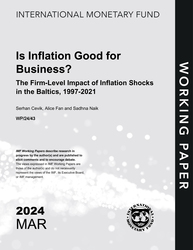
Is Inflation Good for Business? The Firm-Level Impact of Inflation Shocks in the Baltics, 1997-2021
Is Inflation Good for Business? The Firm-Level Impact of Inflation Shocks in the Baltics, 1997-2021
READ MORE...
Volume/Issue:
Volume 2024
Issue 043
Publication date: March 2024
ISBN: 9798400269059
$20.00
Add to Cart by clicking price of the language and format you'd like to purchase
Available Languages and Formats
| English |
Prices in red indicate formats that are not yet available but are forthcoming.
Topics covered in this book
This title contains information about the following subjects.
Click on a subject if you would like to see other titles with the same subjects.
Inflation , Economics- Macroeconomics , Economics / General , Inflation , firm performance , productivity , profitability , fixed investment , Baltics , Estonia , Latvia , Lithuania , inflation shock , inflation volatility , IMF working paper No , 24/43 , nonfinancial firm , impact of inflation , affected total factor productivity , Total factor productivity , Economic recession
Summary
Using a large panel of firm-level data, this paper provides an analysis of how inflation shocks in the Baltics between 1997 and 2021 affected total factor productivity (TFP), gross profitability, and net fixed investment in nonfinancial sectors. First, we find that inflation and inflation volatility had mixed effects on TFP growth, profitability and net fixed investment in the first year as well as over the medium term, albeit at a dissipating rate. Second, focusing on subsamples, we find that inflation shocks had differential effects on large versus small firms. Third, we explore sectoral heterogeneity in how firms responded to inflation shocks and observe significant variation across tradable and non-tradable sectors. Finally, estimates from a state-dependent model suggest that firms’ response to inflation shocks varied with the state of the economy. The results suggest that nonfinancial firms in the Baltics have been agile in adjusting to inflation shocks, possibly by either transferring higher production costs to consumers or substituting inputs. Given the differences in the level and nature of the recent inflation shock and the sample period on which our analysis is based, empirical findings presented in this paper might not necessarily apply to the latest bout of inflation in the Baltics.
Copyright © 2010 - 2025
Powered by:
AIDC



